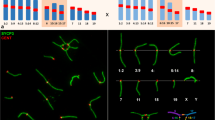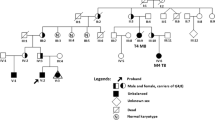Summary
Equations have been derived for two different models of chromosome pairing and chiasmata distribution. The first model represents the normal condition and assumes complete synapsis of homologous bivalents and the arms of interchange quadrivalents. This is followed by a nonrandom distribution of chiasmata among bivalents and multivalents such that each bivalent or bivalent-equivalent always has at least one chiasma. Univalents occur only as part of a III, I configuration at diakinesis or metaphase I. The second model assumes that a hologenomic mutation is present in which all chromosomes of a genome are equally affected. Two different assumptions can be made for such a mutation, and both give the same results: (1) homologous or homoeologous chromosome arms may be randomly paired or unpaired, but synapsis always leads to a crossover; (2) homologous or homoeologous arms always pair, but chiasmata are randomly distributed among the arms. The meiotic configurations at diakinesis or metaphase I are the same for both assumptions. Meiotic configurations of normal diploid interchange heterozygotes show good agreement with numbers predicted by the equations for nonrandom chiasmata distribution among configurations. Inter-specific hybrids with supernumerary chromosomes produced meiotic configurations frequencies in agreement with predictions of equations for random chiasmata distribution, but a hybrid without supernumeraries fitted the nonrandom expectations.
Similar content being viewed by others
References
Avivi L, Feldman M (1980) Arrangement of chromosomes in the interphase nucleus of plants. Hum Genet 55:281–295
Evans GM, Davies EW (1983) Fertility and stability of induced polyploids. In: Brandham PE, Bennett MD (eds) Kew chromosome conference II. Allen & Unwin, London, pp 139–146
Evans GM, Macefield AJ (1973) The effect of B chromosomes on homoeologous pairing in species hybrids. 1. Lolium temulentum X Lolium perenne. Chromosoma 41:63–73
Evans GM, Macefield AJ (1974) The effect of B chromosomes on homoeologous pairing in species hybrids. 2. Lolium multiflorum X Lolium perenne. Chromosoma 45:369–378
Feldman M, Strauss I, Vardi A (1979) Chromosome pairing of F1 hybrids of Aegilops longissima and Ae. searsii. Can J Genet Cytol 21:261–272
Hobolth P (1981) Chromosome pairing in allohexaploid wheat var. ‘Chinese Spring.’ transformation of multivalents into bivalents, a mechanism for exclusive bivalent formation. Carlsberg Res Commun 46:129–173
Jackson RC (1982) Polyploidy and diploidy: new perspectives on meiotic chromosome pairing and its evolutionary implications. Am J Bot 69:1512–1523
Jackson RC (1984) Chromosome pairing in species and hybrids. In: Grant WF (ed) Plant biosystematics. Academic Press, Canada, pp 67–86
Jackson RC, Casey J (1982) Cytogenetic analyses of autopolyploids: models and methods for triploids to octoploids. Am J Bot 69:487–501
Jackson RC, Hauber DP (1982) Autotetraploid and autotriploid cytogenetic analyses: correction coefficients for proposed binomial models. Am J Bot 69:644–646
Jackson RC, Hauber DP (eds) (1983) Polyploidy. Benchmark papers in genetics, vol 12. Hutchinson Ross, Stroudsburg
Jackson RC, Murray BG (1983) Colchicine induced quadrivalent formation in Helianthus: Evidence of ancient polyploidy. Theor Appl Genet 64:219–222
Jackson RC, Newmark P (1960) Effects of supernumerary chromosomes on production of pigment in Haplopappus gracilis. Science 132:1316–1317
Jones RN (1975) B chromosome systems in flowering plants and animal species. Int Rev Cytol 40:1–100
Jones RN, Rees H (1967) Genotypic control of chromosome behavior in rye. 1. The influence of B chromosomes upon meiosis. Heredity 22:333–347
Jones RN, Rees H (1969) An anomalous variation due to B chromosomes in rye. Heredity 24:265–271
Jones RN, Rees H (1982) B chromosomes. Academic Press, London
Murray BG (1976) The cytology of the genus Briza L. (Gramineae). 3. B chromosomes. Chromosoma 59:73–81
Murray BG (1978) B chromosomes and multivalent formation in tetraploid hybrids between Briza media and Briza elatior. Heredity 41:227–231
Murray BG, Jackson RC, Barker NR (1983) Cryptic genome homologies revealed by premeiotic treatment of meiocytes. In: Brandham PE, Bennett MD (eds) Kew chromosome conference, vol II. Allen & Unwin, London, pp 165–171
Murray BG, Sieber VK, Jackson RC (1984) Further evidence for the presence of meiotic pairing control genes in Alopecurus L. (Gramineae). Genetica 63:13–17
Parker JS (1975) Chromosome specific control of chiasma formation. Chromosoma 49:391–406
Sybenga J (1970) Simultaneous negative and positive chiasma interference across the break point in interchange heterozygotes. Genetica 41:209–230
Tease C, Jones GH (1976) Chromosome-specific control of chiasma formation in Crepis capillaris. Chromosoma 57:33–49
Yacobi YZ, Mello-Sampayo T, Feldman M (1982) Genetic induction of bivalent interlocking in common wheat. Chromosoma 87:165–175
Author information
Authors and Affiliations
Additional information
Communicated by A. R. Hallauer
Rights and permissions
About this article
Cite this article
Jackson, R.C., Murray, B.G. Quantitative analysis of diploid translocation heterozygotes: test of models and equations. Theoret. Appl. Genetics 71, 600–606 (1986). https://doi.org/10.1007/BF00264263
Received:
Accepted:
Issue Date:
DOI: https://doi.org/10.1007/BF00264263




